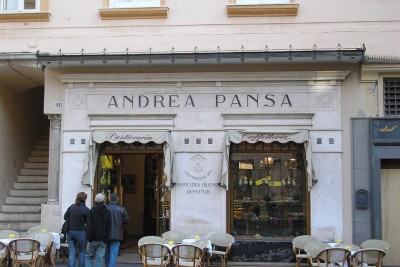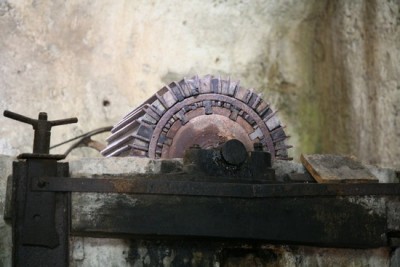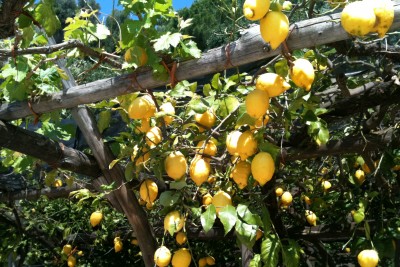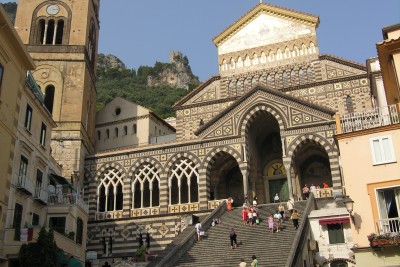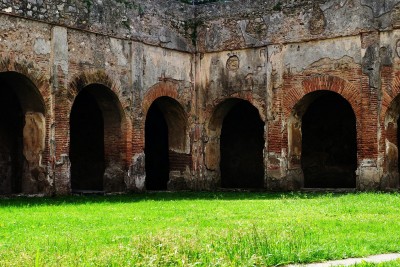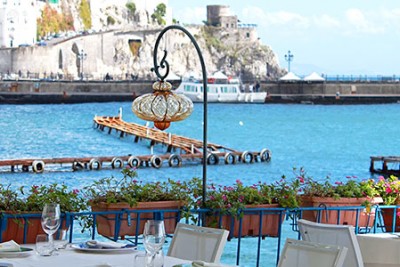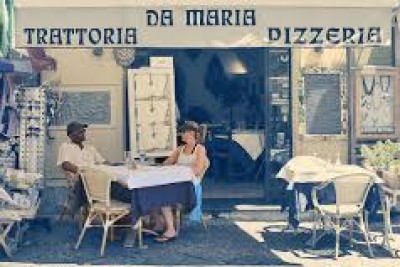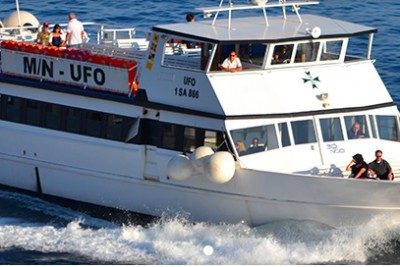Our Insider Guide to Amalfi
Its closely spaced houses, climbing up the steep hillsides and connected by a maze of alleys or stairs, are reminiscent of the souks of the Levant




According to the legend, Amalfi was founded in the 4th century by Romans coming back from Constantinople. First they stopped at Palinuro to found Melphe (hence they were called Melphitani) and then later moved north and founded Amalfi (A-Melphes).
Most probably, however, Amalfi was founded in the 4th century AD when a new Roman colony in nearby Lucania came under barbarian attack and its inhabitants moved to the fertile and well-watered hilly area around what later would become Ravello.
The discovery of fragments of Roman marble proves that the area has been inhabited since Roman Imperial times.
In 553 it became part of the Byzantine Duchy of Naples.
In 596 it was a fortified town that resisted barbarians attacks until 838, when it was conquered and looted by Sicardo. After his death the town, which owed only token allegiance to Byzantium, declared its independence.
Amalfi was first ruled by two prefects, then by judges and finally by a duke, or doge.
The duchy of Amalfi came to embrace almost the entire north coast of the Gulf of Salerno up to Sorrento, from the sea to the Lattari Mountains. Between the early 9th and late 11th centuries, with the sea power of Byzantium in decline, Amalfi became a maritime trading power. It had a near-monopoly of trade in the lower Mediterranean Sea, selling Italian products (wood, iron, weapons, wine, and fruit) in eastern markets and buying spices, perfumes, pearls, jewels, textiles, and carpets to sell in the west.
A distinctive Arab-Sicilian architecture originated and developed in Amalfi: the closely spaced houses, climbing up the steep hillsides and connected by a maze of alleys and stairs, are reminiscent of the souks of the Levant. In the 11th century, the Republic reached the pinnacle of its power thanks to trade with the Middle East.
Amalfi had its own bases in Constantinople, Beirut, Syrian Tripoli, Cyprus and Alexandria of Egypt, and the Amalfitani also built churches and hospitals in Jerusalem. For centuries the maritime laws of the Republic, the famous Tables of Amalfi (preserved in the Museo Municipale, or Town Hall Museum), were considered the code of commerce throughout the Mediterranean.
The nautical compass was also perfected in Amalfi.
The eastern connections also brought new or improved crafts to the area: paper processing, tanning, silkworm cultivation, the weaving of silk, and polychrome glazed pottery production. Wool was also spun, woven and exported throughout Italy; and coral was made into luxury objects, and pasta production and cuisine refined.
The decline of the independent Republic came after the 11th century, mostly due to internal struggles. The Normans, who landed in the area Amalfi in 1003 on their way back from the Holy Land, conquered the city in 1073.
Arguably the most famous town on the Amalfi Coast, Amalfi is very scenic, with narrow and picturesque streets, similar to the winding streets of a medina.
Piazza Flavio Gioia (#1 on the map), in front of the port, is named after the navigator who perfected the use of the compass - between the end of the 12th century and the beginning of the 13th, the Amalfitani were the first in Europe to rely on the property of the magnet.
 The statue in the center of the piazza is of the navigator, Flavio Gioia.
The statue in the center of the piazza is of the navigator, Flavio Gioia.
Crossing the square toward the center of town, at the beginning of via Matteo Camera, two pointed arches hide the remains of the Arsenali della Repubblica (#2), or Arsenal of the Republic where large galleys with 12-16 oars, among the biggest of the time, were built. Open: 9:30am to 12:30am and 4pm-7pm.

Arsenale, interior
In the center of the Piazza del Duomo is a fountain dedicated to the patron saint of Amalfi, St. Andrew, but the piazza is dominated by the Duomo (#3), or Cathedral of Amalfi, set high on top of steep, wide steps.

Built in the 9th century, it is the most important monument on the Amalfi Coast.
The original façade collapsed in 1861 and was later rebuilt. The large mosaic in the tympanum, depicting Christ enthroned among the evangelists, was also completed in that period.
To the left of the prospectus, and not aligned with it, stands the bell tower, which was started before 1180 and completed in 1276.
On the top of the Cathedral steps is the atrium, rebuilt after the collapse of the façade, but only partly following its original design. The space is divided in two by columns. From there, one enters the Cathedral, the Church of the Crucifix and the ancient cemetery, also known as the Cloister of Paradise.
Originally there were two churches, both with three naves. The first one (the Church of the Crucifix ) is the old Cathedral, built between 959 and 1004; the second, wider and with a transept, was built some time before 1066, when its bronze doors were cast in Constantinople.

In that period, an early Christian tradition of having two basilicas was common in the region and both churches were officiated at the same time. The bronze doors depicting Christ, the Virgin Mary and St. Peter and St. Andrew with silver inlaid were donated by the Amalfi colony in the Holy City.
The cathedral, rebuilt in Baroque style, has a Latin cross plan with three naves divided by pillars covered with inlaid marble that, in some cases, enclose ancient columns (one example is in the 7th pillar).
At the entrance of the presbytery, there are two ancient monolithic columns and two candlesticks with mosaic decoration dating back to the 13th century. The altar is modern but was built with medieval marble.
On the left-hand side, probably part of the primitive church, there are two small chapels with frescoes of the miracles and effigies of saints, including Gerardo Sasso of Amalfi, founder of the order of Malta.

In the center, the glass cases contain part of the cathedral treasure: a delicate embroidery of the Angevin Mitre (1297) made of gold, gems and 19,000 pearls; a finely chiseled Chalice in silver-gilt with enamel, pearls and gems (14th century); a 18th century Chinese Sedan from Macao; rare pieces of silver of the Neapolitan School; and the magnificent Falca (a wooden part) of a 15th century Venetian Galley used by Saracen pirates to attack the city (tradition says that the pirates were ship-wrecked by a terrible storm invoked by St. Andrew, Amalfi’s Patron Saint, to protect the people of Amalfi).
During the Fourth Crusade, Cardinal Pietro Capuano swiped Andrew's relics from Constantinople and brought them to Amalfi. The relics arrived on May 8, 1208 and were placed in the cathedral's crypt, where they remain today.
Towards the back, near the first column on the right, there is a “Madonna with Child” 16th century fresco.

The Chiostro del Paradiso (#4), or Cloister of Paradise, which is accessed from the left of the atrium of the Cathedral, was built in 1266-68 as a cemetery for Amalfi’s most illustrious citizens.
It was abandoned in the early 17th century and restored in 1908.

The structure of entwined arabesque arches rests on 120 marble columns.

On the left are tombstones and sarcophagi from different periods and chapels built by patrons between the 12th and 14th centuries. At the back, is a small chapel with a fresco of “Christ Pantacreator” and a magnificent “Crucifixion” from the school of Giotto (Roberto D’Oderisio).
In the collection of the Museo Diocesano (in the Church of the Crucifix ) there are fragments of 11th century mosaics from the façade of the cathedral; colorful 13th mosaic panels from two of the Cathedral’s pulpits; two Roman sarcophagi adorned with bas-reliefs; two ancient columns with eagles; a 14th century statue of Justice; a 14th century sarcophagus with the Madonna and Child and the apostles; arches decorated with 13th century mosaic and fragments of the 12th century façade of the Cathedral.
 At the end of the right aisle of the Church of the Crucifix is the entrance to the Cripta di Sant'Andrea, or Crypt of St Andrew.
At the end of the right aisle of the Church of the Crucifix is the entrance to the Cripta di Sant'Andrea, or Crypt of St Andrew.
 Built in the 13th century but renovated in 1719, it has two aisles, with walls covered in marble and stuccoes. During the Fourth Crusade, Cardinal Pietro Capuano swiped Andrew's relics from Constantinople and brought them to Amalfi. The relics arrived on May 8, 1208 and were placed under the altar of the crypt, where they remain today. The relics are held in a silver urn under the central altar.
Built in the 13th century but renovated in 1719, it has two aisles, with walls covered in marble and stuccoes. During the Fourth Crusade, Cardinal Pietro Capuano swiped Andrew's relics from Constantinople and brought them to Amalfi. The relics arrived on May 8, 1208 and were placed under the altar of the crypt, where they remain today. The relics are held in a silver urn under the central altar.
The marble statues of St. Stephen and St. Lawrence are by Pietro Bernini.
The Museo Civico (#5, visit by appointment only) houses the "Tabula amalphitana", the code containing the maritime laws of the Republic of Amalfi. It consists of 66 chapters, 21 of which are in Latin.
 Although this version dates back probably from the 15th century, the wordings of the code go back to a much earlier age, probably late 11th or early 12th century.
Although this version dates back probably from the 15th century, the wordings of the code go back to a much earlier age, probably late 11th or early 12th century.
Also worth visiting in Amalfi is the Museo della Carta (#6), or Museum of Hand-Made Amalfi Paper (see our story HERE).

ATRANI
Part of Amalfi until the 16th century, Atrani is just a thousand yards away, toward Vietri.
Populated by the most important noble families of the Amalfi Republic (the Doges were crowned and buried here), it is one of the most picturesque spots on the Costiera.
Its intricate road system is made of narrow streets, steps and overpasses traversing houses, orchards and gardens and is one of the best preserved examples of the of the Amalfi Coast urban architecture.
The Chiesa di San Salvatore de Birecto, where the Doges were elected and buried, is in Piazza Umberto I, the center of the town.

The church was founded in 940 and completely transformed in 1810. The portal, with 12th century carved doorposts, was closed by a bronze door, which was moved to the Collegiata di Santa Maria. The interior has three naves. Along the right one, there is a 12th century piece with two peacocks side by side with their feathers furled, divided by a palm tree with a bird nesting.
The Collegiata di Santa Maria with a spectacular view of the Gulf of Salerno, is a monumental complex built in 1274 but whose use changed several times. It has a Baroque façade, a majolica dome and an elegant bell tower.
 The church has a bronze door, similar to that of the Cathedral of Amalfi, which was cast in Constantinople.
The church has a bronze door, similar to that of the Cathedral of Amalfi, which was cast in Constantinople.
About 3 miles south of Amalfi, on the road that leads to Vietri and Salerno, outside of the town of Maiori, is the Abbey of Santa Maria de Olearia, one of the most important Benedictine monastic settlements in the area (open from Easter week until the end of July on Wednesdays from 2.30 PM till 6.30 PM, Saturdays from 9.00 AM till 1.00 PM and Sundays from 9.00 AM till 1.00 PM).

Details of its foundation date back to Amalfi’s first Archbishop, Leone – in office from 987 until his death in 1029 - who gave permission to Pietro, a hermit who lived there with his nephew Giovanni, to build the church of Santa Maria dell’Olearia, on the site where olive oil was pressed.

The medieval frescoes, which date back to the Carolingian and late ancient culture, are the highlights of the Abbey are the Figures of Saints (10th and 11th century); the Virgin Praying, the Offerer of the Church (11th century) and Incarnation and Passion.
 The chapel of San Nicola is home to the frescoes of the Virgin, San Nicola and San Paolino; Miracles of San Nicola; Processions of Saints and Christ Pantocrator; and Angels.
The chapel of San Nicola is home to the frescoes of the Virgin, San Nicola and San Paolino; Miracles of San Nicola; Processions of Saints and Christ Pantocrator; and Angels.
For printing our Amalfi Guide (facing pages) you can download the PDF by clicking HERE
For offline reading on your smartphone or tablet, you can download the PDF of our Amalfi Guide (single page) by clicking HERE
If you have an Android OS, you will find it in your Download app.
If you have an iPhone or an iPad, open and save it in iBook (free app).
Watch a video
Also on Amalfi

